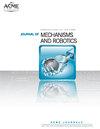可展开混凝土模板的运动学
IF 3.2
4区 计算机科学
Q2 ENGINEERING, MECHANICAL
Journal of Mechanisms and Robotics-Transactions of the Asme
Pub Date : 2023-09-07
DOI:10.1115/1.4063371
引用次数: 0
摘要
对传统的混凝土模板进行改造,设计了一种超约束可展开框架。它由剪刀形元件和正交伸缩杆组成的闭环可展开单元组成。利用倒螺旋理论,研究了具有一个自由度的可展开框架的可动性。为了分析车架在展开和折叠过程中的运动性能以及不同展开状态下车架在外部载荷作用下的静态特性,提出了一种用螺旋形式建模分析车架运动学和静力学的通用方法。关节的速度可以在螺旋坐标系中求解,关节的位置和加速度可以分别通过一阶数值积分和一阶数值微分插值得到。然后,将每个关节的位置信息转发到静力平衡方程中。通过各展开状态下的静力分析,推导出各杆的内力和主动控制力。运动学和静力学通过使用速度作为全局变量相关联,从而允许对机构进行统一分析。该方法计算效率高,适用于各种多刚体机构的运动学和静力学分析。本文章由计算机程序翻译,如有差异,请以英文原文为准。
Kinetostatics of Deployable Concrete Formworks
To reform the traditional concrete formwork, an overconstrained deployable frame is designed. It is composed of closed-loop deployable units formed by scissor-form elements and orthogonal telescoping rods. Using the reciprocal screw theory, the mobility of the deployable frame is studied, and it has one degree of freedom (DoF). To analyze the kinematic performance of the frame in the deployment and folding processes and the static characteristics under external loads at different deployed states, a general approach to analyzing the kinematics and statics by modeling in screw form is proposed. The velocities of joints could be solved in screw coordinates, the position and acceleration of joints could be obtained via a first-order numerical integration and a first-order numerical differential interpolation, respectively. Then, the position information for each joint can be forwarded onto the static equilibrium equations. Through the static analysis at each deployed state, the inner forces in each rod and the active control forces are derived. Kinematics and statics are associated by using velocities as the global variable, which allows a unified analysis of mechanisms. This method is computationally highly efficient and also fits for kinematic and static analysis of different kinds of multi-rigid-body mechanisms.
求助全文
通过发布文献求助,成功后即可免费获取论文全文。
去求助
来源期刊

Journal of Mechanisms and Robotics-Transactions of the Asme
ENGINEERING, MECHANICAL-ROBOTICS
CiteScore
5.60
自引率
15.40%
发文量
131
审稿时长
4.5 months
期刊介绍:
Fundamental theory, algorithms, design, manufacture, and experimental validation for mechanisms and robots; Theoretical and applied kinematics; Mechanism synthesis and design; Analysis and design of robot manipulators, hands and legs, soft robotics, compliant mechanisms, origami and folded robots, printed robots, and haptic devices; Novel fabrication; Actuation and control techniques for mechanisms and robotics; Bio-inspired approaches to mechanism and robot design; Mechanics and design of micro- and nano-scale devices.
 求助内容:
求助内容: 应助结果提醒方式:
应助结果提醒方式:


